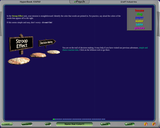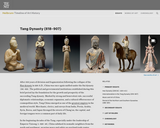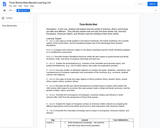
In this lesson, students learn about the need for rules and structure.
- Subject:
- Social Studies
- Material Type:
- Lesson Plan
- Provider:
- Bright Hub Education
- Author:
- Patricia Gable
- Date Added:
- 02/26/2019

In this lesson, students learn about the need for rules and structure.

Students will view and discuss Cy Twombly's "Nine Discourses on Commodus", research the Roman Emperor Commodus, investigate Twombly's process and technique, and consider the difference between works in a "series" created as "one in a sequence" rather than "stand alones". Students will also discuss how music may inspire visual arts; make paintings based on phrases of poetry; and debate the artistic value of graffiti.

Students will learn about Lunsord Lane and the accomplishments he had a a slave and a freed black man.

In this lesson, students read primary and secondary source documents about the Supreme Court cases Strauder v. West Virginia, Smith v. State of Texas, the 14th amendment, and racial discrimination in jury selection. Students then answer analysis questions about the cases.

Students will explore how various black entrepreneurs thrived in Durham's downtown, so much so that Durham's Parrish Street was soon known as Black Wall Street. Students will gain a sense of the challenges overcome and successes experienced by the various black entrepreneurs and businesses on Black Wall Street.

This is an online activity which allows students to learn about and experience the Stroop Effect in Psychology.

Students consider how different societies define freedom of expression, analyze historical sources that reveal contrasting views on freedom of expression in the case of Skokie, Illinois, where a Nazi group attempted to demonstrate in the 1970s, and explore the recent free speech controversy in the wake of the Charlie Hebdo attacks.

In this lesson, students research recent US Supreme Court cases and analyze their impact on rights of citizens.

This article examines the Tang Dynasty of China. Marked by strong and benevolent rule, successful diplomatic relationships, economic expansion, and a cultural efflorescence of cosmopolitan style, Tang China emerged as one of the greatest empires in the medieval world.

In this lesson, students read primary and secondary source documents about the Supreme Court case Taylor v. Louisiana and the 6th and 14th amendments. Students then answer analysis questions about the case. There is a teacher answer key included in the lesson.

A teacher's guide to Laura Hillenbrand's Unbroken. Contains discussion questions, research and writing prompts and background information.

This article provides an overview of energy education curriculum materials available from the National Energy Education Development (NEED) Project. Teachers may become a member, or use free online resources.

Students will learn that archaeologists use historic photographs to interpret archaeological sites and artifacts. They will use observation, inference, and comparing skills to interpret a historic photograph.

This free website provides more than 600 adaptable lesson plans written by teachers in collaboration with the Denver Art Museum for more than 130 objects from the museums world-class art collection. Lesson plans and resources focus on inspiring students to think and problem-solve creatively. Organized in an easy way so that teachers can pick the topic they would like to explore or enhance, then use works of art to teach that subject.
High resolution images are included. Museum visits are not necessary to implement lesson plans. Includes professional and student development tools such as teacher workshops and webinars, virtual classroom courses, career videos, educator blogs and creativity tools. Easy for teachers in language arts, social studies and visual arts to provide a curriculum rooted in the arts while also meeting 21st Century Skills.

In this lesson, students will learn about the case of Dorothy E. Davis, et al. vs. County School Board of Prince Edward County, Virginia using primary source materials. This case predated the Brown vs Board of Education case and was brought about by a 16 year old student who complied the data about the differences between her all black school and the all white school.

In this lesson, students will identify the roles that people have in the school and explain the importance of each member. They will show their appreciate for the jobs these people do by writing and delivering letters.

Students will identify and analyze the historical data found within two newspapers reporting on Robert Smalls and the CSS Planter.

In this unit, students will explore how the worlds of America, Africa, and Europe are alike and different. They will also explore how and why the three worlds met, and how Europeans, American Indians, and Africans view the meeting of their three worlds.

Students will take a close look at an object that was made by an immigrant who came to the United States. Then children will consider important moments in their family history. This resource is connected with the Smithsonian Musuem.

In this lesson, students read primary and secondary source documents about the Supreme Court case Tinker v. Des Moines and freedom of speech. Students then answer analysis questions about the case.